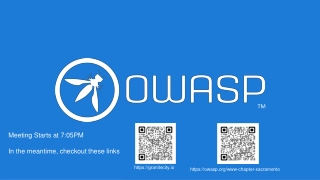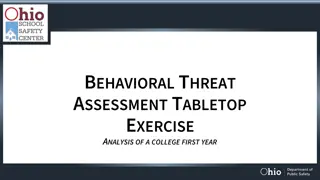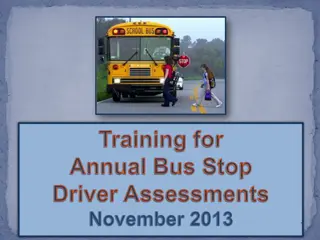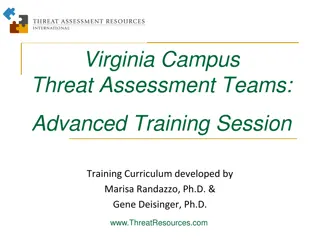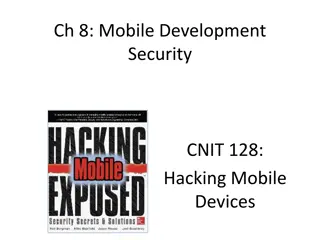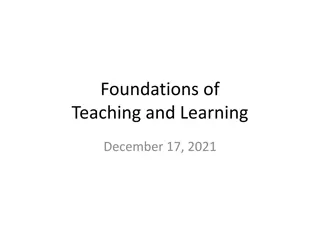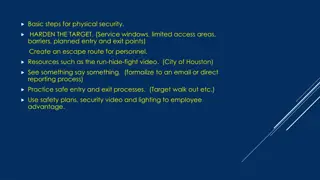School Safety and Threat Assessment Program Overview
Fact-based Threat Assessment for Safe and Supportive School Programs involves identifying, inquiring, assessing, and managing potentially dangerous situations. It aims to distinguish between those making threats and those posing real risks, without profiling or labeling individuals. Understanding the Pathway to Violence and the non-impulsive nature of attacks is crucial. Building a comprehensive Threat Assessment Program is essential for early intervention and violence prevention in schools.
Download Presentation

Please find below an Image/Link to download the presentation.
The content on the website is provided AS IS for your information and personal use only. It may not be sold, licensed, or shared on other websites without obtaining consent from the author. Download presentation by click this link. If you encounter any issues during the download, it is possible that the publisher has removed the file from their server.
E N D
Presentation Transcript
Safe and Supportive School Program (SSSP) Behavioral Threat Assessment Teams Brownsville Independent School District August 2022
Crisis Management Threat Assessments FFB Legal Policy (SB 11) The board shall establish a threat assessment and safe and supportive school team to serve at each campus of the district and shall adopt policies and procedures for the teams. The team is responsible for developing and implementing the safe and supportive school program in compliance with Texas Education Agency (TEA) rules at the district campus served by the team. The policies and procedures adopted under Education Code 37.115 must: 1. Be consistent with the model policies and procedures developed by the Texas School Safety Center [see Education Code 37.220]; 2. Require each team to complete training provided by the Texas School Safety Center or a regional Education Service Center (ESC) regarding evidence-based threat assessment programs; and 3. Require each team established under this section to report the required information regarding the team s activities to TEA.
What is a Threat Assessment? A Threat Assessment is a fact-based, systematic process designed to IDENTIFY, INQUIRE, ASSESS, AND MANAGE potentially dangerous or violent situations. A behavioral threat assessment is a deductive inquiry that examines facts, draws a conclusion and provides strategies and interventions. A key goal is to distinguish between someone MAKING a threat and someone POSING a threat to prevent targeted violence. Threat assessment involves asking: Is this person on a pathway to violence? If so, how can we get this person off the pathway to violence? How can we help them solve their problem, fix their situation, or address their condition in a non-violent way?
A Threat Assessment is NOT: A simple checklist of warning signs or red flags used to remove a student from school. A means to label a student as a troublemaker and enact consequences A means to find the next school shooter Threat Assessment is not profiling. It is not making a generalization about an individual based on the individual s similarity to others who have perpetrated attacks in the past.
Understanding the Pathway to Violence One of the first facts about school shootings or target violence attacks is that they are rarely impulsive; these attackers typically don t just snap . Typically attackers think about and plan the attacks in advance ranging from days to years prior. The following graphic illustrates the pathway to violence typically taken by those who have engaged in school shootings and other acts of targeted violence: o It begins with an idea to do harm, developing a plan to carry it out, preparing by acquiring the means of capacity to do harm and then implementing the violent act.
Building a Threat Assessment Program The threat assessment serves to: identify students of concern assess their risk for engaging in violence or other harmful activities and identify intervention strategies to manage that risk. Building a school threat assessment program targeted at violence prevention consists of eight steps that include: Establishing a multidisciplinary team Defining prohibited and concerning behaviors Creating a central reporting mechanism Defining threshold for law enforcement intervention Establishing threat assessment procedures Developing risk management options Creating and promoting a safe school climate Conducting training for all stakeholders
Safe and Supportive School Program Threat Assessment Team Guidelines The Superintendent shall ensure that the members appointed to each team have expertise in counseling, behavior management, mental health and substance use, classroom instruction, special education, school administration, school safety and security, emergency management, and law enforcement. On determination that a student or other individual poses a serious risk of violence to self or others, a team shall immediately report the team s determination to the Superintendent. If the individual is a student, the Superintendent shall immediately attempt to inform the parent or person standing in parental relation to the student. These requirements do not prevent an employee of the school from acting immediately to prevent an imminent threat or respond to an emergency. A team identifying a student at risk of suicide shall act in accordance with the district s suicide prevention program. If the student at risk of suicide also makes a threat of violence to others, the team shall conduct a threat assessment in addition to actions taken in accordance with the district s suicide prevention program. A team identifying a student using or possessing tobacco, drugs, or alcohol shall act in accordance with district policies and procedures related to substance use prevention and intervention.
Campus Threat Assessment Team Members Counseling Behavior management Mental health and substance abuse Classroom instruction Special education School administration School safety and security Emergency planning Law enforcement Campus Administrator: School Counselor: Police Officer: School Nurse: Teacher: Other Designated Members:
Safe and Supportive School Program Threat Assessment Team Duties Each team shall: 1. Conduct a threat assessment that includes assessing and reporting individuals who make threats of violence or exhibit harmful, threatening, or violent behavior in accordance with district policies and procedures; and gathering and analyzing data to determine the level of risk and appropriate intervention, including: a. Referring a student for mental health assessment; and b. Implementing an escalation procedure, if appropriate, based on the team s assessment in accordance with district policy; 2. Provide guidance to students and school employees on recognizing harmful, threatening, or violent behavior that may pose a threat to the community, school, or individual; and 3. Support the district in implementing the district s multi-hazard emergency operations plan [see CKC].
Brownsville ISD has existing policies that identify prohibitive behaviors: Written, verbal or behaviors of Threats of Violence: in person or online Engaging in violence Prohibited materials Bullying Cyberbullying Harassment Stalking Weapons Social Media Internet Usage Fighting Other prohibited behaviors
Concerning Behaviors: Any information that is concerning, troubling, or upsetting should be reported to the threat assessment team - or to an administrator, counselor or teacher or through a tip line. Examples may include and are not limited to: Threatening statements, gestures, and /or artistic impressions. Persons with ongoing, unresolved grievances with member of the school community. Unusual or bizarre communications or behavior. Information about someone expressing thoughts, plans or preparation for violence. Concerns that someone may harm themselves. Behavior that seems troubling or disturbing. Persons seeming isolated and alienated from others. Anyone unknown to the school. Anything out of the ordinary observed or stated that may pose a risk of harm
Other Possible Behaviors for Screening Intervention: Marked decline in performance Increased absenteeism or isolation Sudden or dramatic change in behavior or appearance Erratic, depressive, or other mental health symptoms Other behaviors as identified
Considerations while in Remote Learning Remind school staff, parents, and students that they should still report threats and other concerning behavior in a remote environment and that the team is still functioning. Faculty and staff should refer to Crisis Protocols to report a student in imminent danger while in at-home learning mode Remind students that see something, say something and do something still applies in a virtual environment, and that they may be the first person to become aware of a peer who is struggling or may need help.
Threat Assessment Procedures Step #1 Receive and screen report about a person of concern ****** Utilize Threat Assessment Screening Tool***** Screen report for imminence. Imminent Threats should be reported to law enforcement immediately. Screen report to determine need for full threat assessment STEP #2: Gather information about the person and situation *****Utilize Threat Assessment Case Worksheet***** Teachers / Administrators, School Staff, Coach / Employer, Parents, Social media sites / Internet, Local law enforcement, After-school / weekend programs, Community level entities, Person of Concern, Other:
Step #3 Organize and analyze information using 11 investigative questions ****** Utilize 11 Investigative Questions Worksheet****** Step #4 Make an assessment about whether the person poses a threat *****Utilize the Make the Assessment Worksheet***** Step #5 IF NEEDED: Develop & Implement case management strategies ***** (IF NEEDED: Utilize case management worksheet)*****
Step #6 Re-assess and change plan if needed: Once a case management plan has been developed and implemented, the team should: Monitor the person of concern and situation Evaluate the management plan to determine if it is having the intended effect Determine if there any new concerns Re-assess the person of concern by answering (again) the two assessment questions Change the case management plan if necessary Continue to monitor and re-assess as needed Step #7 Close and document the case: When the team s assessment is that the person of concern does not pose a threat of violence or self-harm the team can close the case. The team should be sure to document the case, including scheduling any future dates to check-in or follow-up if needed.
Encourage Reporting of Concerning Behaviors Overcome the Bystander Effect To help the bystander be more actively engaged in supporting the safety and well-being of the school, members of the community need to know that: it is everyone s role and responsibility to recognize any concern and to respond and report concerns to the persons who can best help the situation. reports of concerning statements and concerning behaviors should be reported without hesitation. reports can be in person or by phone or online. Reports can also be made anonymously. reports are wanted all reports will be screened there will be regular reminders and ongoing training on the topic of school safety
How and Where to Report Concerning Behaviors Students, parents, faculty, staff, community members may contact: Brownsville ISD Police Department to make a report at (956) 698-3115. Reports are accepted 24 hours a day, seven days a week. Campus administrator, counselor, or teacher in-person or by contacting the school campus by phone at (956) 548-8000. Reports can be made anonymously by calling the BISD Crimestoppers Hotline at (956)408-0049 or online at P3campus.com.
See Something, Say Something, Do Something Challenge https://www.dhs.gov/see-something-say-something/ take-challenge Click on the above link Watch and take the 3 Challenge? How did you do? See Something, Say Something, Do Something
Resources Texas State Texas School Safety Center School Behavioral Threat Assessment training https://txssc.txstate.edu/ United States Homeland Security https://search.usa.gov/search?utf8=%E2%9C%93&affiliate=dhs&dc =&channel=&query=threat+assessment&search- type=dhs&commit=Search
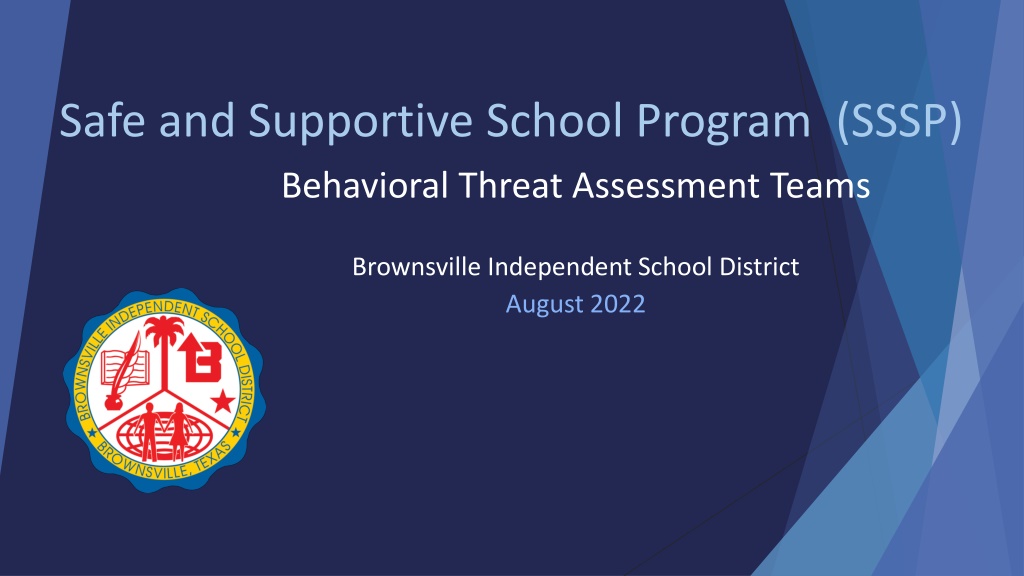
 undefined
undefined




